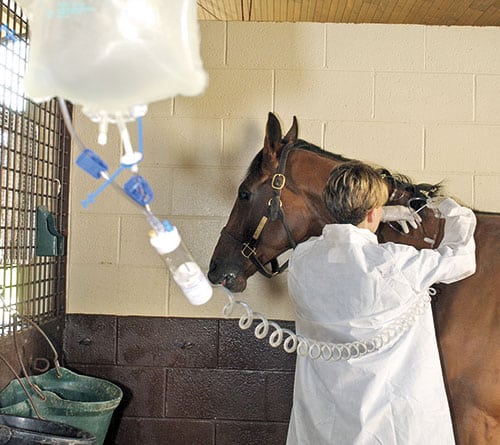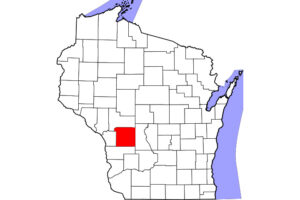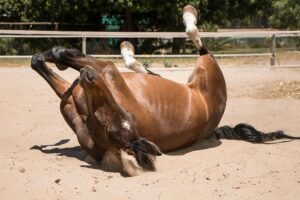Fluid Therapy: A Life-Saving Measure

The purpose of fluid therapy in horses is to enhance recovery from life-threatening diseases by correcting dehydration and shock. Depending on the disease and its severity, veterinarians have four fluid therapy options: voluntary oral intake, enteral, infusion per rectum, and intravenous.
Fluid Therapy Options
Voluntary oral intake is a mainstay suitable for many situations, such as correcting dehydration after an endurance event. It typically involves supervised access to water, plain or with added salt. This simple, physiologically appropriate, and inexpensive system can replace water lost through sweat and respiration.
Enteral fluid therapy involves a veterinarian infusing water or a mixture of water and electrolytes (balanced to resemble plasma) into the intestinal tract through a nasogastric tube passed through the nostrils as needed or left in place. The vet might administer it intermittently or by continuous infusion to break down a large colon impaction of dehydrated feedstuff, which is a common cause of colic. It both protects against and treats dehydration. Both enteral methods pose advantages and disadvantages related to technical issues, facilities, and monitoring. The intermittent infusion rate for an average adult horse is approximately 10 liters (about 2.5 gallons) every four hours, depending on tolerance and other variables. Continuous enteral infusion involves placing a small-bore tube to allow continuous infusion by gravity from a suspended container at 5 to 10 liters (1.3 to 2.5 gallons) per hour.
Continuous per rectum infusion of balanced electrolyte solutions or plain water should not be confused with an enema, although both are delivered the same way: with great care to prevent rupture of the small colon (the final portion of the large intestine) and rectum. An enema can stimulate colonic motility and soften an impaction. For rehydration, veterinarians use the same method at a lower infusion rate through an indwelling small-bore tube. Absorption of water by the small colon can hydrate the horse to the same extent as enteral therapy and would be suitable for diseases that delay outflow from the stomach (e.g., gastric ulcers, lack of gastrointestinal motility).
Intravenous (IV) fluid therapy involves infusing fluid through an IV catheter, usually in the jugular vein, according to two protocols—replacement or maintenance—determined by the horse’s needs and disease status. Replacement therapy or fluid resuscitation involves infusing large volumes of sterile physiologic solutions similar to plasma to restore losses from diseases such as enteritis (intestinal inflammation), colic, renal damage, and exertional rhabdomyolysis (“tying-up”). Veterinarians base delivery rate on clinical assessment of response to the therapy and lab test results.
Maintenance IV fluid therapy provides water and electrolytes to horses that are not allowed or are unable to eat or drink because of their disease status. It is designed to offset daily losses through normal bodily functions (sweating, breathing, urination, defecation). The daily rate of delivery is 30 liters or 8 U.S. liquid gallons to an average-sized adult horse. Although maintenance therapy is not intended to replace fluid and electrolyte losses, it can be used as an approximate starting point for replacement therapy.
Treatment with IV fluids requires an understanding of many factors affecting maintenance needs. One is food intake: Healthy horses that are not fed for transportation, competition, general anesthesia, or disease reasons consume 16% of the water that fed horses do. Diet composition, stall confinement, physical activity, fever, and lactation can also affect water needs. Veterinarians treat foals with fluid therapy as they would adults, but neonates have larger fluid compartments and blood volumes than older horses. Vets must factor this into their calculations of water and electrolyte needs.
Effectively delivering sufficient fluids to as large an animal as an adult horse can be challenging. However, veterinarians are increasingly aware that overhydration is possible in horses, just as in human patients, with similar consequences. A major complication from overhydration with IV fluids is increased urine flow and the loss of critical electrolytes. Volume overload can also damage capillaries and cause fluid retention in tissue spaces. Preliminary data from a hospital population of horses after major colic surgery suggested that a low volume of fluids might provide some benefit and no adverse effects, compared with more traditional high rates of delivery. An added benefit to a more conservative approach is its lower cost—a clear benefit when considering the high cost of sterile IV fluids. However, the goal should always be to provide this important life-saving therapy when indicated, with full regard for the great benefits and potential complications.
Written by:
David Freeman, MVB, MRCVS, PhD, Dipl. ACVS
Related Articles
Stay on top of the most recent Horse Health news with



















